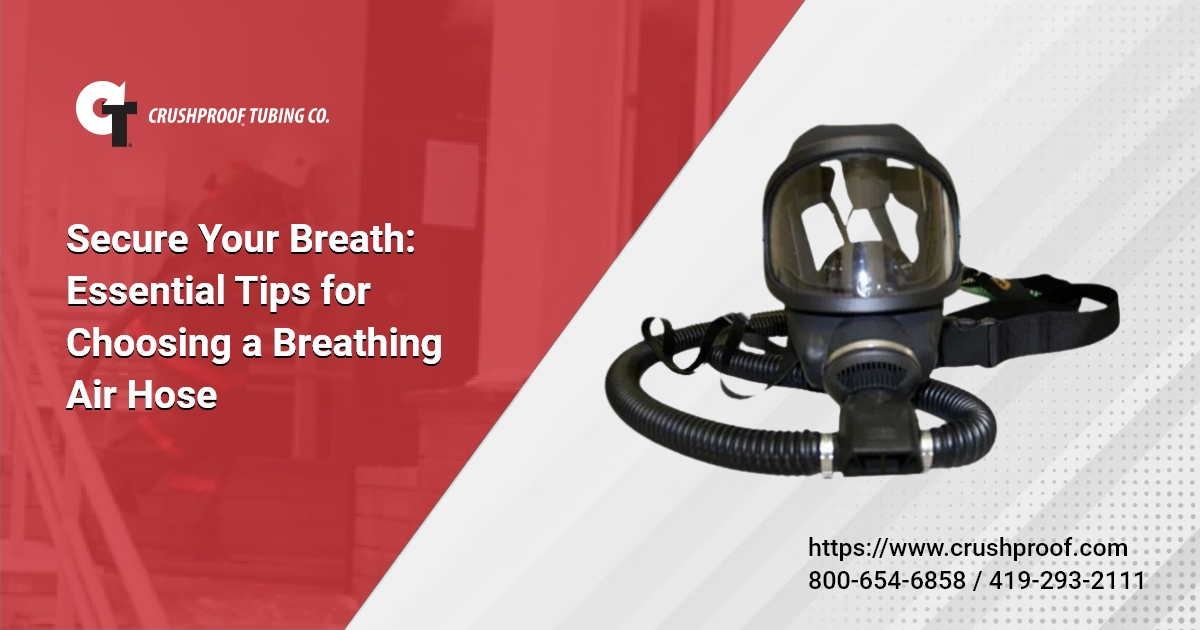Essential Insights: What to Know Before Buying a Breathing Air Hose
Breathing air hoses are essential components of respiratory protection equipment and are designed to deliver clean, breathable air to users in hazardous environments. Common applications include military, firefighting, industrial safety, medical, and diving breathing systems. Their suitability for these applications depends on factors like hose design, type, material, and exposure duration. This post offers you insights on different types of breathing air hoses and offers tips on their design.
Types of Breathing Hose Systems
Breathing safety applications fall into some wide categories based on the environment they go into and level of safety required.
- CBRN: This stands for Chemical, Biological, Radiological, and Nuclear. Systems like these are designed to provide respiratory protection against hazardous chemicals, nuclear materials, biological contaminants, radioactive particles, and so on and are primarily used by the military.
- CCR: This stands for Closed-Circuit Rebreather hoses that are designed to recycle exhaled air and replenish oxygen for the user to breathe underwater. This is commonly used in recreational diving, military/tactical diving, and marine research applications.
- SCBA: This stands for Self-Contained Breathing Apparatus hoses, which are used by emergency service professionals such as firefighters, rescue workers, and so on. These hoses enable the users to breathe in environments filled with smoke and dust.
- PAPR: This stands for Powered Air-Purifying Respirator hoses. They are used by the military and first responders in CBRN applications as well as by professionals in pharmaceutical, healthcare, and manufacturing sectors for continuous flow of clean air.
A Few Popular Breathing Hose Designs for Your Consideration
Any of the above listed categories of breathing system could use any of these hose designs. That said, each offers unique properties that could make it better or worse for any given system depending on its requirements.
- Annular: This is a tube with a consecutive series of ribs, or convolutions. It offers easy and predictable bending.
- Spiral: Offers a continuous helix design with a smooth cuff on each end. This makes them easy to drain, which is important if liquid disinfectant is used for cleaning. The downside is that in a stretch version they can twist a bit when fully extended.
- Stretched vs Spaced: In a spaced design, the ribs are far enough apart that there is a wide peak and valley structure. This results in the lowest part weight, which is often important. Stretch hoses have up to a 1:4 compression to stretch ratio, which makes them extremely flexible. They are heavier per inch at their resting length than a spaced design, but can offer user comfort and flexibility that is far superior to the spaced version.
Factors to Consider When Choosing a Breathing Air Hose
Choosing a breathing air hose of your application requires careful consideration of factors, such as operational environment, designs, efficiency, and challenges. The following are a few additional factors to be addressed.
- Material: Commonly used materials are rubber types such as butyl, EPDM, nitrile, or neoprene and plastics such as HDPE and LDPE. The rubber blends are far more durable and robust and offer superior chemical resistance in most cases, but are heavier and more expensive than plastic tubing.
- Diameter, Length, and Wall Thickness: Inner diameter, length, and wall thickness of the hose influences the pressure drop and air flow across it. A hose of sufficient length and a large diameter can support higher air flow with less pressure loss than hoses with narrow diameters. The length and wall thickness must be chosen based on the distance between the user and the air source, which seems obvious, but full range of movement, stress on connections and seals, and hose routing make these calculations a bit harder. The hose needs to be long enough for proper movement and sealing, but short enough that it does not have large amounts of slack that can get caught on things. Longer distances are harder to push air through due to friction loss and pressure drops.
- Compatibility: The hose must be compatible with the fittings or connectors in your respiratory protection system because safety is a direct function of seal quality.
- Certifications and Standards: Choose hoses that meet relevant safety standards such as NATO AEP54 and NIOSH CBRN standards. Adherence to these standards mean that hoses are safe for use in their intended environments.
- Flexibility and Weight: Lighter and flexible hoses ensure user comfort in applications that require significant movement but may compromise gas permeation resistance and/or durability. Finding the right balance is key.
- Maintenance: Make sure your material can stand up to the required cleaning or decontamination requirements of the application.
If you require breathing hoses for your application, ensure you source them from a quality manufacturer. Crushproof Tubing has been making breathing air hoses for various applications and environments, such as diving, medical, military, hazardous industrial applications, and so on for over 75 years. We can provide breathing air hoses made of materials, including EPDM, neoprene rubber, nitrile, LDPE and HDPE plastic. They are available in various colors, and specifications, such as annular and spiral convolutions, lengths from 2″ to 10’, diameters from 3/8″ and up with nearly limitless size options. We can meet NATO AEP54 and NIOSH CBRN standards for mustard and sarin gas applications. All these hoses can be offered in special cuff sizing, which means they can fit different couplings and connectors on each side. If you need customized breathing air hoses, contact us today . Alternately, if you are looking for custom parts at off-the-shelf prices, you can check-out our Build-A-Hose page. We can provide you custom sample within a week of ordering.


